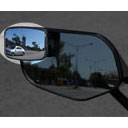
When you get your motor home, do not assume you can simply jump in and drive away. It will be totally different to your normal car in every way and you will need to get to know it-particularly the blind spots.
In a car, you have blind spots mainly down each side, behind the line of your best sideways glance. These are more or less similarly shaped and sized and the best defence is proper use of your wing mirrors.
In a motor home the situation is more complicated and dangerous. The extra width and length of the motor home, combined with the blocking of vision from the rear view mirror, takes the issue to another level.
The side mirrors will need to be set further away from the side of the vehicle in an attempt to gain some vision around the back and reduce the blind spot there. The driver has to familiarize himself with use of the wide mirrors on both sides to get the real benefit.
The size of the vehicle and the fact that the driver sits much nearer to one wing mirror than the other means that the near-side blind spot will be much larger than that on the off-side. The shadow of invisibility is much longer and this is a real danger when the driver considers driving in a middle lane.
Investigating the size and location of the blind spots before moving the vehicle is crucial. Do this by having someone walk around while you check the mirrors. Be aware that it will take much longer for another vehicle to emerge from the blind spot when you are moving. So each movement from lane to lane should be delayed and undertaken with caution.
The rear blind spot can also be targeted by video camera.
